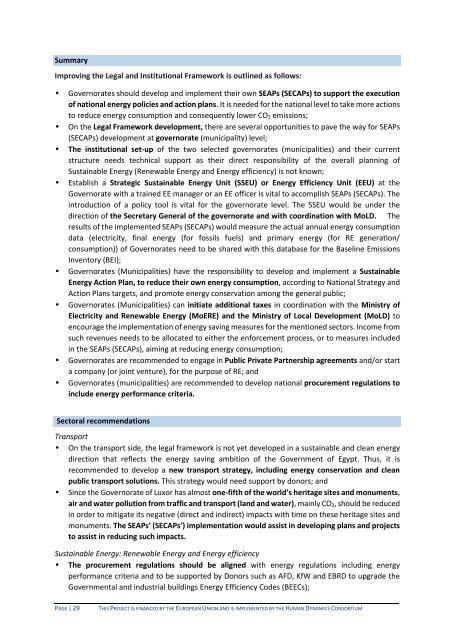180917_CES-MED_National_Report_Egypt_FINAL2rev
Create successful ePaper yourself
Turn your PDF publications into a flip-book with our unique Google optimized e-Paper software.
Summary<br />
Improving the Legal and Institutional Framework is outlined as follows:<br />
• Governorates should develop and implement their own SEAPs (SECAPs) to support the execution<br />
of national energy policies and action plans. It is needed for the national level to take more actions<br />
to reduce energy consumption and consequently lower CO 2 emissions;<br />
• On the Legal Framework development, there are several opportunities to pave the way for SEAPs<br />
(SECAPs) development at governorate (municipality) level;<br />
• The institutional set‐up of the two selected governorates (municipalities) and their current<br />
structure needs technical support as their direct responsibility of the overall planning of<br />
Sustainable Energy (Renewable Energy and Energy efficiency) is not known;<br />
• Establish a Strategic Sustainable Energy Unit (SSEU) or Energy Efficiency Unit (EEU) at the<br />
Governorate with a trained EE manager or an EE officer is vital to accomplish SEAPs (SECAPs). The<br />
introduction of a policy tool is vital for the governorate level. The SSEU would be under the<br />
direction of the Secretary General of the governorate and with coordination with MoLD. The<br />
results of the implemented SEAPs (SECAPs) would measure the actual annual energy consumption<br />
data (electricity, final energy (for fossils fuels) and primary energy (for RE generation/<br />
consumption)) of Governorates need to be shared with this database for the Baseline Emissions<br />
Inventory (BEI);<br />
• Governorates (Municipalities) have the responsibility to develop and implement a Sustainable<br />
Energy Action Plan, to reduce their own energy consumption, according to <strong>National</strong> Strategy and<br />
Action Plans targets, and promote energy conservation among the general public;<br />
• Governorates (Municipalities) can initiate additional taxes in coordination with the Ministry of<br />
Electricity and Renewable Energy (MoERE) and the Ministry of Local Development (MoLD) to<br />
encourage the implementation of energy saving measures for the mentioned sectors. Income from<br />
such revenues needs to be allocated to either the enforcement process, or to measures included<br />
in the SEAPs (SECAPs), aiming at reducing energy consumption;<br />
• Governorates are recommended to engage in Public Private Partnership agreements and/or start<br />
a company (or joint venture), for the purpose of RE; and<br />
• Governorates (municipalities) are recommended to develop national procurement regulations to<br />
include energy performance criteria.<br />
Sectoral recommendations<br />
Transport<br />
• On the transport side, the legal framework is not yet developed in a sustainable and clean energy<br />
direction that reflects the energy saving ambition of the Government of <strong>Egypt</strong>. Thus, it is<br />
recommended to develop a new transport strategy, including energy conservation and clean<br />
public transport solutions. This strategy would need support by donors; and<br />
• Since the Governorate of Luxor has almost one-fifth of the world’s heritage sites and monuments,<br />
air and water pollution from traffic and transport (land and water), mainly CO 2, should be reduced<br />
in order to mitigate its negative (direct and indirect) impacts with time on these heritage sites and<br />
monuments. The SEAPs’ (SECAPs’) implementation would assist in developing plans and projects<br />
to assist in reducing such impacts.<br />
Sustainable Energy: Renewable Energy and Energy efficiency<br />
• The procurement regulations should be aligned with energy regulations including energy<br />
performance criteria and to be supported by Donors such as AFD, KfW and EBRD to upgrade the<br />
Governmental and industrial buildings Energy Efficiency Codes (BEECs);<br />
PAGE | 29<br />
THIS PROJECT IS FINANCED BY THE EUROPEAN UNION AND IS IMPLEMENTED BY THE HUMAN DYNAMICS CONSORTIUM

















